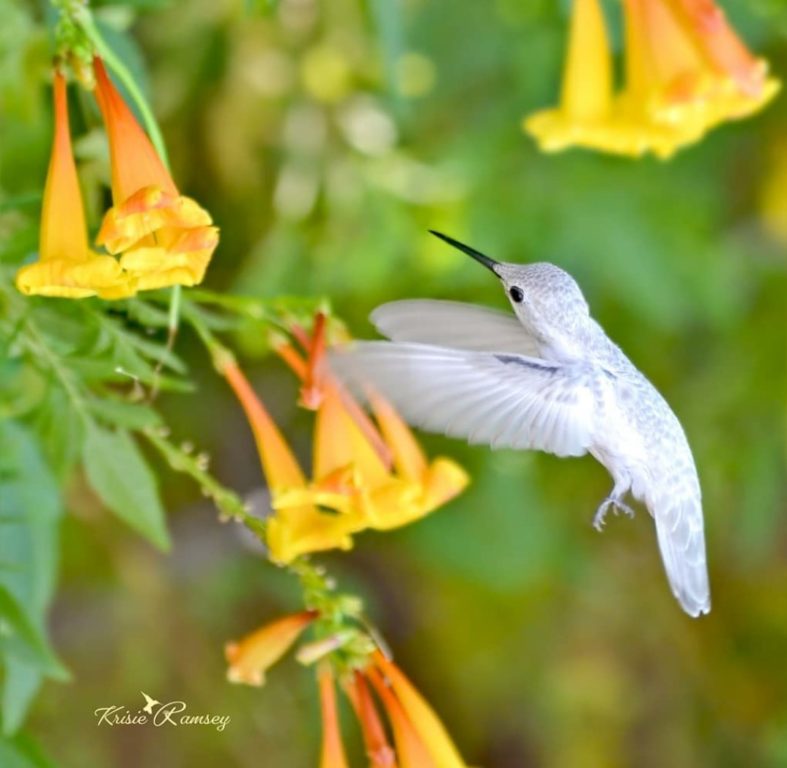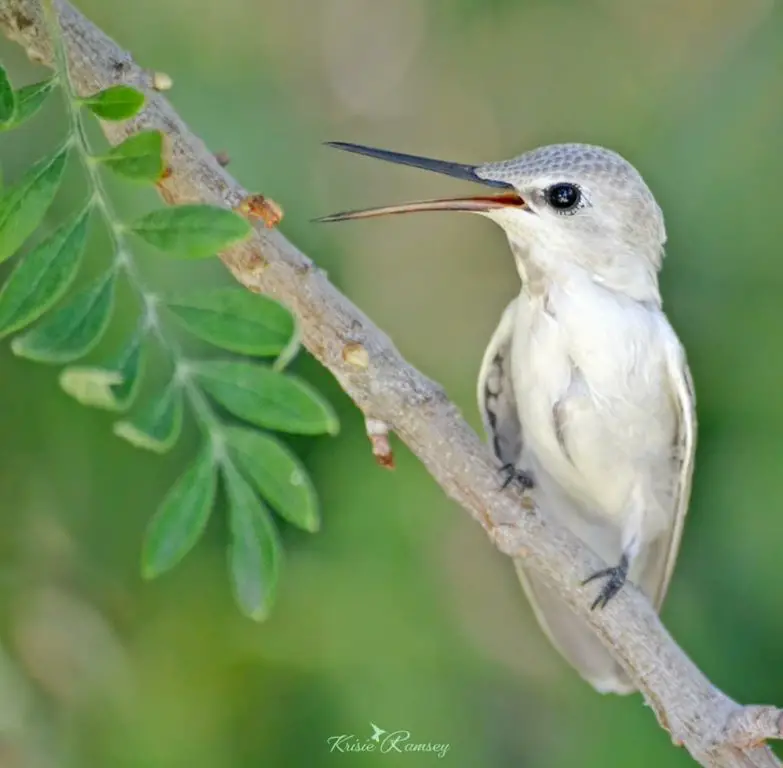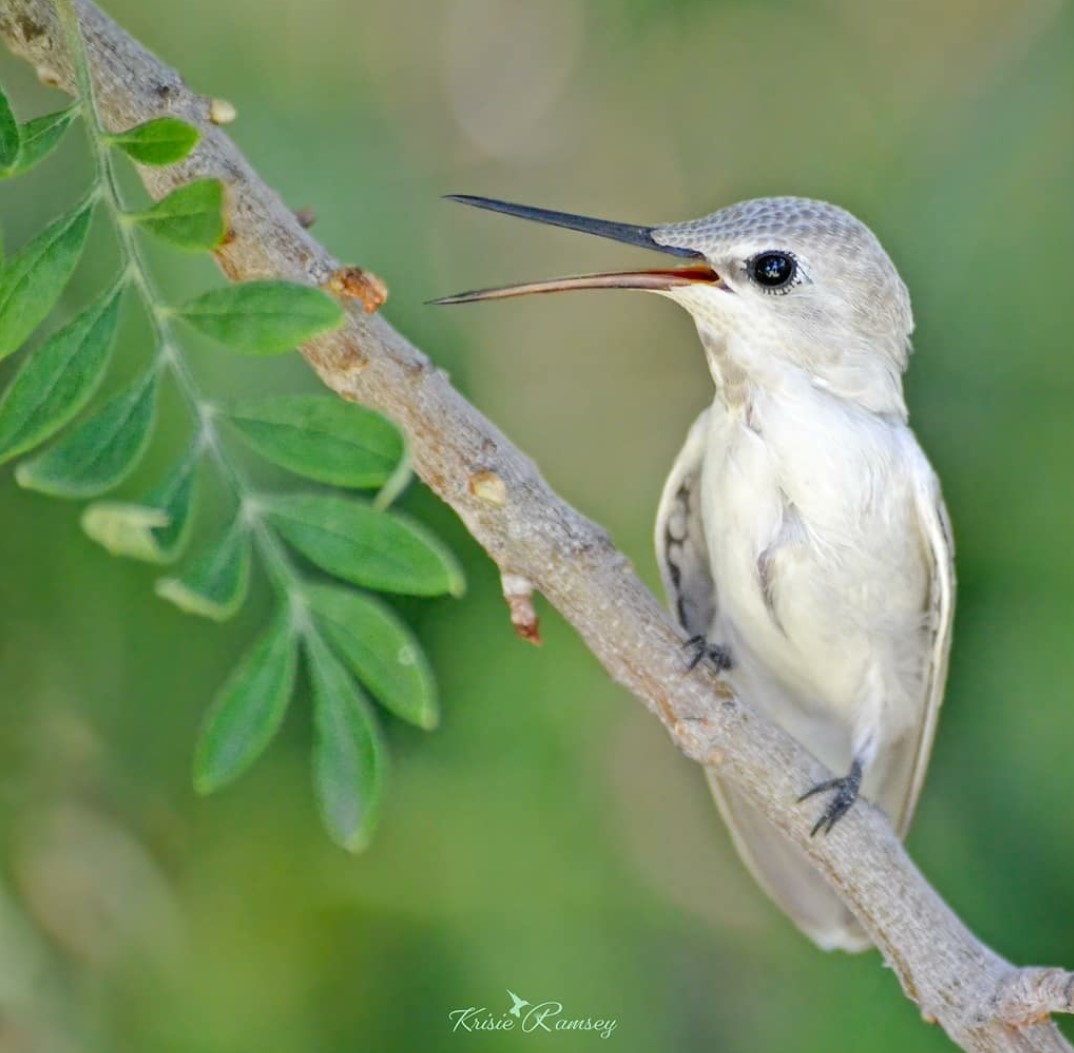This post contains affiliate links.
With any animal species, there is always that one conspicuous individual in the crowd who steals the spotlight. Whether it’s an albino snake, tiger, alligator, shrimp or Plecostomus (algae eater) there are even albino hummingbirds! Any animal can have albinism which is a recessive genetic trait.
What makes an albino hummingbird white?
Albinism is a hereditary disease caused by genetic mutations, reducing melanin or pigment production. For a hummingbird, melanin is an essential part of producing skin tone, eye color, feather strength, and ultraviolet sun protection. The less melanin produced the lighter the skin, the more melanin production the darker the skin.
Hummingbird albinism is subdivided into two categories: Albino and Leucistic. These two groups are easily misidentified. Both types of sightings are sparse and uncommon, however leucistic hummingbirds are spotted more often than true albinos.
Albino Hummingbirds
Researchers have documented and seen less than 100 albino hummingbirds combined, reported in North, Central, and South America. Genuine white albino hummingbirds are extremely rare and beautiful.
People tend to get albino and leucistic hummingbird sightings confused. The exact and true figure of albino sightings is unknown because partial albinos or leucistic hummingbird sightings are being mixed and counted, creating skewed data.
Authentic albino hummingbirds lack melanin which results in having no color or pigmentation in their skin, eyes, and feathers. This genetic mutation will make the hummingbird appear all white in color.
Their eyes, feet, legs, and even claws can look pink or red due to the red blood vessels becoming more visible in appearance through their white complexion.
The albinism trait is more susceptible to the offspring when both parents carry the recessive gene.
This hereditary disadvantage makes these hummingbirds a successful target to be caught by poachers and prey.
Researchers have captured and tagged albino hummingbirds to study, but have not been successful in finding them the next year to further their research.
Following up previous investigations without successfully locating the original hummingbird makes documentation of albino hummingbirds extremely difficult, therefore, the longevity of an albino hummingbird is undetermined by experts.
If there is any chance of spotting an albino hummingbird out in the wild or at a feeder it is recommended to take as many pictures as possible, since they are rare.
Share them with wildlife groups and on social media to spread the word and the wonderful sightings of these beautifully exquisite and rare creatures.
Leucistic Hummingbirds
Leucistic hummingbirds are a form of albinism and they are partially affected producing less pigment in color than pure albino hummingbirds.
The small amount of pigment that the leucistic hummingbird produces is displayed as a patchy or spotty coloration on their feathers. It can be presented as an irregular dot on a white portrait to any conceivable pattern limited to combinations of grey, brown, tan or beige.
Their color modifications make them extremely noticeable and eye-catching. Their grey and beige colorations can look similar to a Leucistic Mourning Dove.
The eyes and feet of a leucistic hummingbird stay black. Their beaks can be tan or black in color.

Photo by: krisieramsey
Taken in: Tempe, Arizona
A poor diet can result in a leucistic hummingbird struggling to produce melanin.
Researchers still don’t have a clear answer if leucism in hummingbirds makes their appearance less desirable to a potential mate.
Survival Hazards
Being an unusual creature of beauty, albino and leucistic hummingbirds have extra obstacles to overcome in order to survive. These obstacles include:
Being easily identifiable can fail in their efforts to camouflage or hide in their natural surroundings for protection. Albino hummingbirds are easily targeted and extremely noticeable by other prey. They have a greater risk of being recognized at night by being a white mass standing in a sea of black. They are more susceptible to being eaten by cats or hawks at night.
Rejection by family members, potential mates, and social interactions are common. Their white visual appearance is extremely noticeable receiving unwelcomed interactions from other groups. This is done to reduce the spread of genetic mutations and to keep their heritage line clean.
White hummingbird feathers are weaker and more brittle than normally pigmented feathers. Due to its fragile state, the feathers tend to break easier and may make it more difficult for hummingbirds to fly during migration. This puts a strain on the hummingbird’s ability to stay warm and insulated during the winter months.
Albino hummingbirds may be more susceptible to diseases and genetic abnormalities.
The rare and noteworthy light colored complexion is considered of value and is desired by poachers. This can lead to an increased number of deaths and be unfavorable for the hummingbird species.
Disadvantages and problems of locating nutrition to survive. Due to their decreased sight and hearing compared to their peers, they have a slower response time which will subject them to potential predators. Albino hummingbirds have a better chance of surviving in a setting where they are protected in captivity.
Is it legal to capture or own a hummingbird?
In the United States, it is illegal to keep in captivity or have in possession a wild hummingbird as a household pet, infringing on the Migratory Bird Treaty Act of 1918. This includes anything to do with hummingbird nests, eggs or babies due to them being wild animals.
Violating or breaching this law results in a heavy fine of up to $200,000 in US dollars.
The only entities allowed to temporarily or permanently possess live hummingbirds are zoos and rescue sites for teaching or rehabilitation purposes.
See my article: Is it Safe for a Human to Touch a Hummingbird?
Even though it is illegal to capture a hummingbird in the United States I found a story on the internet that talked about a man and his dog rescuing a sick hummingbird covered in ants that looked dead and nurtured it back to health. The three became inseparable and had their moment of fame on a local news station.
More than a year since the hummingbird was rescued the man leaves his doors and windows open hoping she will leave safely and return to nature to find a mate.
Final Thoughts: Confessions of a True Albino Hummingbird
Dear Diary,
As much as I want to fit in with the rest of my relatives I am different. I am easily misidentified and by revealing my true identity will expose my impostures.
My eyes, beak, and feet are pink or red in color. My wings are brittle and my eyesight is diminished. I require extra care and would fare better in a protected environment.
Yet, I stand alone, lavishing in my own pure beauty as I am extremely rare and difficult to find.
Therefore, if you locate me when you are out in nature, enjoy my distinction, take a picture, lavish in the delight that you have memorialized my existence, and share me with the rest of the world.
Yours truly,
Confessions of a True Albino Hummingbird
Happy Hummingbird Watching!

Photo by: krisieramsey
Taken in: Tempe, Arizona
Backyard Visitors is a participant in the Amazon Services LLC Associates Program, an affiliate advertising program designed to provide a means for sites to earn advertising fees by advertising and linking to Amazon.com. We also participate in other affiliate programs which compensate us for referring traffic.

